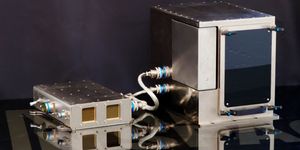For patients with diabetes, managing their blood sugar levels requires constant care and vigilance. To make regulating the insulin levels easier and less painful, scientists have produced a ‘smart’ insulin patch filled with beta cells that can sense blood sugar levels and secrete insulin as needed.
The study was published in
Advanced Materials by a team from the University of North Carolina at Chapel Hill and North Carolina State University. The basis of their innovation was a patch made of synthetic polymers that are covered in tiny nanoscale microneedles, which they developed as a
proof-of-principle last year. In the latest improved version, the needles on the patch are filled with actual live beta cells instead of an insulin solution.
"This study provides a potential solution for the tough problem of rejection, which has long plagued studies on pancreatic cell transplants for diabetes," said Zhen Gu, assistant professor in the joint UNC/NC State department of biomedical engineering and senior study author. "Plus it demonstrates that we can build a bridge between the physiological signals within the body and these therapeutic cells outside the body to keep glucose levels under control."
Insulin is a hormone produced naturally in the body that stimulates the uptake of glucose in the body’s cells. In diabetes there is a deficiency of insulin, either because beta cells in the pancreas are unable to produce insulin (Type 1 diabetes), or the normal insulin is produced in insufficiently quantities (Type 2 diabetes). Both forms of diabetes require external insulin therapy, as without insulin glucose levels can rise dangerously high and can affect many other cellular functions of the body.
Though it may sound painful – a patch with hundreds of needles poking out – the device is about the size of a quarter, and the microneedles are about the diameter of an eyelash. The needles are necessary to connect the patch to the internal blood vessels of the body. And each of these needles contains thousands of live beta cells encapsulated in a alginate mixture. The patch also contains “glucose-signal amplifers” – chemical megaphones that relay crucial blood sugar levels to the insulin-producing beta cells.
In studies using type-1 diabetic mice, the researchers found the patch released insulin in response to increased blood glucose levels in 10 hour intervals. To demonstrate the patch is ‘smart’ and can sense when NOT to release insulin, researchers applied a second patch. As expected, insulin was not released in excess, and the glucose levels in the mice stabilized for a total of 20 hours.
That the patch can sense and regulate insulin release is a huge advantage of this live cell system. This means there’s no danger of insulin over-dose, which would result in excessively low blood sugar (hypoglycemia), an equally dangerous condition for diabetics. "Managing diabetes is tough for patients because they have to think about it 24 hours a day, seven days a week, for the rest of their lives," said John Buse, professor of medicine at the UNC School of Medicine and co-author of the study. "These smart insulin approaches are exciting because they hold the promise of giving patients some time off with regards to their diabetes self-care. It would not be a cure but a desperately needed vacation," he added.
Additional source:
UNC press release









